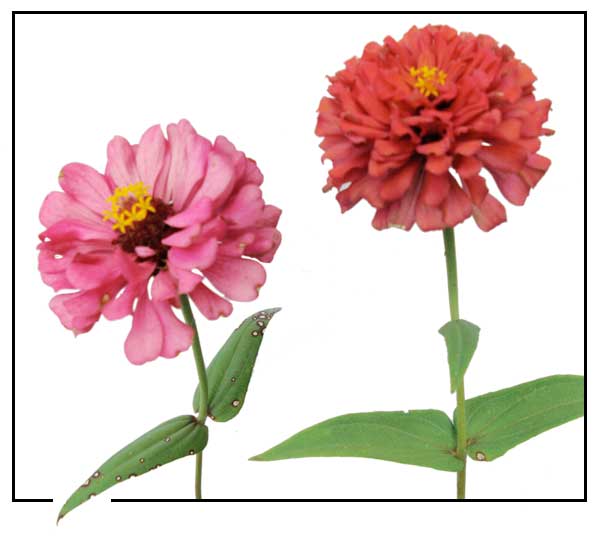
Gen
info
- Zinnia is a common Mexican wildflower.
The early Spanish colonists in Mexico found the flowers ugly and called
them mal de ojos (evil eyes). The genus was
named after German botanist who first named it, Johann Gottfried Zinn
of Gottingen. Of the 200 or more species
in the zinnia genus, Zinnia elegans is the most well known of the 20 or more species in the zinnia genus.
- Today, they are popular worldwide for their beauty and longevity. Vased, the cut flowers can last two weeks. They are easy to grow, and quite hardy, growing almost anywhere as long as there is sufficient water and sunlight. Zinnias were among the first flowers grown successfully in the International Space Station. (13)
Botany
Zinnia is a low, coarse, erect, upright, annual herb, growing to
a height of 1 to 3 feet. Leaves are opposite, ovate or nearly elliptic,
with the base clasping the stem. Flower head is terminal, single- or
double-flowered. The flowering stalk is 2 to 5 centimeters long. Ray flowers are
reflexed, of various colors, disk flowers usually yellow or orange, but also seen in red, pink, white, and lavender.
Distribution
- Widely distributed in the Philippines.
- Thrives best in deep loamy soil.
- Native to Mexico.
- Propagated by seeds.
Constituents
- Major anthocyanins in red flowers of Zinnia elegans were pelargonidin 35-diglucosides (30%) and cyanidin 3,5-diglucosides (20%). (7)
- Qualitative analysis for secondary metabolites yielded steroids, saponins, flavonoids, phenols, and glycosides. (see study below) (4)
- Chromatographic and spectral studies identified two major anthocyanins in the red flowers: acetylated pelargonidin and cyanidin 3,5-diglucosides. (12)
Properties
- Study suggests antioxidant, antifungal, hepatoprotective, anthelmintic, phytoremediative, antimalarial properties.
Uses
Folkloric
- No known folkloric use in the
Philippines.
- In Brazil, curanderos or traditional healers put zinnia leaves (Z. elegans) on top of a patient's head to cure madness. Also used as ingredients in ritual baths of Brazilian healing ceremonies. (3)
Others
- A plant in the list of medicinal plant candidates for thyroid analogs according to ethnobotanical research n Brazil (Cunha Lima, 2008)
- Ritual / Superstition: The Navajo tribes consider Zinnias as sacred life medicine while the Pueblo people feed the blossoms to children, believing it can make them intelligent and eloquent. (13)(13)
Studies
• Antifungal.
Phytochemical and antifungal screening of the whole plant of Z elegans
yielded 7.6% saponins and showed pronounced antifungal activity against
Fusarium moniliforme. (1)
• Allergenicity / Allergic Rhinitis.
Zinnia elegans pollen from heavily polluted areas in central Tehran has been shown to release compounds that are significantly more potent in eliciting skin wheal reactions and increasing total blood IgE (immunoglobulin E) and eosinophilia in sensitized animals, than pollen compounds from non-polluted areas. (2)
• Hepatoprotective / Antioxidant / Carbon Tetrachloride Toxicity / Leaves.
Study evaluated the hepatoprotective and antioxidant activity of ethanolic extract of leaves of Z. elegans in CCl4-induced toxicity in rats. Silymarin was used as standard. The extract significant suppressed the oxidative stress via its direct scavenging against the reactive oxygen species under CCl4 stress. The extract also improved the lipid profile, LDL and HDL. Hepatotoxicity was significantly suppressed via activation of antioxidant enzymes GST and SOD. (4)
• Phytoremediation / Lead / Allergic Rhinitis.
Study evaluated the ability of two ornamental plants (marigold and zinnia) to uptake lead from contaminated soil. Zinnia elegans showed the greater potential for lead accumulation than marigold. Results suggest an environmentally friendly and cost effective alternative for protecting the contaminated soil from leaching lead. (5)
• Anthelmintic / Leaves: Study evaluated the helmintholytic potential of various extracts of leaf of Zinnia elegans against Eisenia fetida. The methanolic extract of ZE showed significant anthelmintic activity at 10 mg/ml concentration. Albendazole was used as standard drug. (6)
• Anti-Infective / Antimalarial / Metabolomic Profiling: Study evaluated the chemical composition and anti-infective activities of ethanol extracts and fractions of Zinnia elegans and Gazania rigens. Coumarins, sesquiterpenes lactones and phenylethanoids were found characteristic for Z, ekegans. The ethyl acetate fraction of Z. elegans showed significant antimalarial activity with IC50s of 21.03 and 13.72 µg/mL against Plasmodium falcifarum D6 and P. falcifarum W2, respectively. (10)
• Antioxidant / Secondary Metabolites: Study evaluated the potential use of Z. elegans as a source of valuable secondary metabolites. Fractions yielded polyphenolic compounds such as chlorogenic acids and apigenin, kaempferol and quercetn glycosides. Antioxidant assays showed certain fractions exhibited moderate 15-LOX inhibition and metal chelation activities. (11)
Availability
- Wild-crafted.
- Flower essence and seeds in the cybermarket. |





